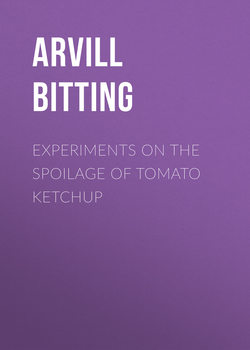Experiments on the Spoilage of Tomato Ketchup

Реклама. ООО «ЛитРес», ИНН: 7719571260.
Оглавление
Arvill Wayne Bitting. Experiments on the Spoilage of Tomato Ketchup
LETTER OF TRANSMITTAL
INTRODUCTION
PROCESS OF MANUFACTURE
SELECTION AND PREPARATION OF STOCK
PULPING
COOKING AND SEASONING
EVAPORATION AND FINISHING
BOTTLING
PROCESSING
CHARACTER OF PRODUCTS
FIRST-CLASS PRODUCTS
INFERIOR PRODUCTS FROM “TRIMMING STOCK.”
LABELS
MANUFACTURING EXPERIMENTS WITHOUT THE USE OF PRESERVATIVES
OUTLINE OF THE EXPERIMENTS
DISCUSSION OF RESULTS
SPOILAGE OF KETCHUP AFTER OPENING
SPOILAGE OF UNOPENED KETCHUP
SPOILAGE OF MARKET BRANDS
STERILITY OF KETCHUP
EXPERIMENTS WITH PRESERVATIVES
SODIUM BENZOATE
SALT
SUGAR
SPICES
WATER INFUSIONS
ACETIC-ACID EXTRACTS
OIL EXTRACTS
VINEGAR AND ACETIC ACID
OIL
STUDY OF PENICILLIUM IN KETCHUP
DEVELOPMENT
REPRODUCTION
GROWTH IN KETCHUP
TEMPERATURE TESTS
HISTOLOGICAL STRUCTURE OF KETCHUP
MICROSCOPIC EXAMINATION OF SOME COMMERCIAL BRANDS
SUMMARY
Отрывок из книги
The tomato, Lycopersicum esculentum, is supposed to be native to South or Central America. The large fruits commonly used grow only under cultivation, but the variety with small, spherical fruits, known as L. cerasiforme, has been found on the shore of Peru and is considered by De Candolle1 as belonging to the same species as L. esculentum. Though grown extensively in Europe, there is nothing to indicate that it was known there before the discovery of America. The tomato was introduced into China and Japan at a comparatively recent date. De Candolle is of the opinion that the tomato was taken to Europe by the Spaniards from Peru and was later introduced into the United States by Europeans. Tomatoes were brought to Salem, Mass., by an Italian painter in 1802,2 who is said to have had difficulty in convincing the people that they were edible. They were used in New Orleans in 1812, though as late as 1835 they were sold by the dozen in Boston. After 1840 they came into general use in the Eastern States, but it was later than this before tomatoes were used freely in the Western States, many persons having the impression that, since they belonged to the nightshade family, they must be unwholesome. The extent to which tomatoes are used at the present time shows how completely this prejudice has been overcome.
The name Lycopersicum is from two Greek words, meaning a wolf, and a peach, the application of these terms not being apparent; the name of the species, esculentum, is from the Latin, meaning eatable. The common name “tomato” is of South or Central American origin, and is believed to be the term used in an ancient American dialect to designate the plant,3 but its meaning is unknown. The English call the tomato “love apple,” which in French is “pomme d’amour.”
.....
The tomatoes should be home-grown, of a red variety having the minimum of yellow and purple color, be picked when ripe, and delivered to the factory promptly without mashing. All tomatoes should pass over an inspection table, the rotten and otherwise unfit fruit should be discarded, and the green tomatoes should be returned to crates to ripen. The stems should be removed when the best color is desired, and the tomatoes should be thoroughly washed to remove dirt and mold. Dumping a crate of tomatoes into a hopper of dirty water and playing a gentle spray of water on part of them merely wets the skin and makes them appear bright.
The clean tomatoes should be conveyed to the steaming tanks and subjected to steam heat until the skins burst and the meat softens. After a short heating the tomatoes should be run through a “cyclone” where the skins, seeds, etc., are removed and they are rubbed to a pulp. To remove very small particles and fiber, the pulp may be run through a sieving machine at once; or, if ketchup of the smoothest possible kind is to be made, this procedure should be delayed until after the cooking. The pulp is collected in a receiving vat, and only such an amount should be provided in advance as will keep the kettles full, as it is better to stop the tomatoes before going to the washer than to have the pulp stand for some hours. In common practice, however, the pulp is either sent to the cooker at once, or it is allowed to stand and partially separate. If tall casks are used for this separation the solids will rise to the top and the clear watery portion is drawn off at the bottom, or the pulp may be strained through cloth bags. The object of this separation is to secure greater concentration of the solids, retain a brighter color, and shorten the time of cooking.
.....